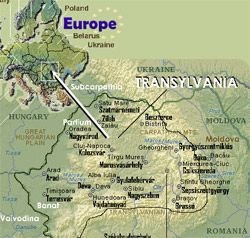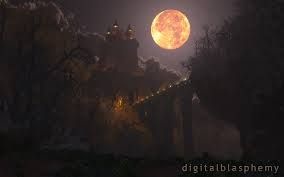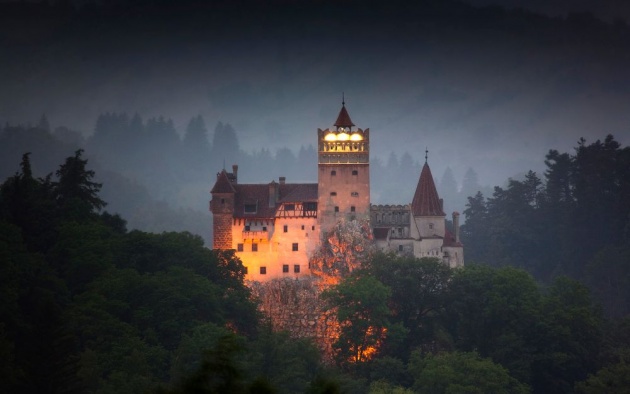

If you're searching for Dracula's Castle, you've come to the right place.
I've uncovered a truly terrifying selection of castles connected to Dracula, all in deepest Transylvania, Romania. Some of these castles are linked to Bram Stoker's vampire - Dracula.
Some others of these castles are linked to an altogether more terrifying character - the 'real life Dracula', or Vlad the Impaler.
You see, Bram Stoker's fictional vampire, Dracula, was based on a real person: Vlad the Impaler. (His real name was Vlad II, Son of the Dragon).
In the 1400s, Vlad was a ruler of modern-day Transylvania and a man with a tremendous appetite for cruelty. His blood-thirst acted as inspiration for Bram Stoker's vampire named Dracula, in the novel written 450 years later.
Let's find out a bit more about the real-life Dracula, and the castles he created - which served as inspiration for the vampire's castle in Bram Stoker's novel.
i love vamires i wish i could be one
A spooky sunset over Bran Castle, Transylvania. Credit: Kyle Taylor CC-BY.2.0
Vlad the Impaler: The 'Real Life Dracula'
Portrait of Vlad III, which was painted in around 1560 - note that this was some years after his death. It's often said that the truth is stranger than fiction. Indeed, according to some, Vlad the Impaler was a more of a gruesome monster than Dracula, who was just a literary creation.
If you're at all squeamish, jump these next few paragraphs, 'cos Vlad, Son of Dracula was a character of truly phenomenal cruelty.
It's estimated by modern scholars that Vlad was responsible for the deaths of more than 80,000 individuals. That's a huge number, but remember the population of Europe in 1400 was 50m people - today it's about 750m. You could multiply 80,000 by 14 (1.1million deaths) to give a more realistic idea of his trail of slaughter in today's terms.
Vlad the Impaler was born Vlad III, Son of Dracula - Dracula being his father's name, roughly translated to 'dragon'. In youth, he was denied his seat on his father's throne of the state of Wallachia. As a result, he became a truly fearless warrior, destined to slaughter the families of all those who opposed his reign of the region.
To create panic and disarray within his enemies, Vlad embarked on gruesome psychological warfare. He chose to impale his victims on sharp spikes - indeed, whole towns of people were often impaled in forests of spikes, as a message to would-be attackers.
But he was a sadistic man that enjoyed cruelty. Often his victims would be hoisted to the top of the spike where they were impaled, and left to die slowly, gravity dragging them down the pole. They'd then be left to rot, as a warning.
This wasn't enough for Vlad, though - he reportedly also enjoyed burning victims alive; gouging out eyes; and chopping off limbs. He saved particular cruelty and brutality for females - committing unspeakable acts to pregnant women.
Victims of a gruesome impaling - depicted in a German pamphlet on Vlad III. These are all facts we know from historical sources, but there are more gruesome rumours that abound. Apparently, Vlad used to drink the blood of his victims; feast next to the remains of impaled corpses; or even cook and eat the flesh of those he killed. It's easy to see the inspiration behind the Dracula novella.
Of course, though, there are two sides to every story. Some modern historians don't doubt the trail of death and destruction wrought by Vlad, but choose to interpret it in a less sensational fashion.
Remember that Vlad was a figure of Medieval times - which were far crueller and more violent than modern life. Back then, a common punishment was hanging - which was probably just as gory and cruel as impaling someone.
Vlad also succeeded where others failed - he created order and justice in a country which was previously lawless. Perhaps, some historians argue, his strong-arm tactics were actually justified - and you might be surprised to see that modern day Romanians look to him as some kind of a hero.
Vlad the Impaler may have been blood-thirsty enough to inspire the creation of Dracula the Vampire - but not everyone sees him as a real monster.
Dracula the Vampire: Bram Stoker's Fiendish Creation
When Bram Stoker's novel 'Dracula' was unleashed upon the world in the 1890s, it was an almost instant sensation. He wasn't the first author to write about vampires.
However his novel was an incredible example of new gothic style - filled with macabre images, seething tension and even (gasp!) sexuality. It quickly became a sensation - and its influence persists to today.
Bram Stoker openly acknowledged that the 'immortal' character of Vlad the Impaler - a many who feasted on bloodshed and cruelty - inspired his creation of Dracula the Vampire.
His novel was also inspired by the Transylvanian folktales of 'strigoi' - ghosts who rise at night to wander the countryside, and suck the blood of their victims.
Classic Dracula - as played by Bela Lugosi. Credit: Tom Margie CC-BY.2.0 Bram Stoker travelled to Romania to uncover ideas and inspiration to strengthen his novel. We know that he would have seen many castles - in photographs at least - but modern day scholars can find no evidence of one particular castle that acted as inspiration for his work.
All in all, we have to assume that Dracula's Castle - as featured in Bram Stoker's novel - is a work of fiction and an amalgamation of many smaller castles. Indeed, as the novel itself admits, "I was not able to light on any map or work giving the exact locality of the Castle Dracula" - it is undoubtedly a place of myth and legends.
A Collection of Castles All Linked To Dracula
The truth is that there's no single 'Dracula's castle' somewhere in the world. Instead, there are a multitude of spooky castles in Transylvania connected to the Dracula legends. All these castles were connected to Vlad the Impaler, the 'real life Dracula'; and all of them acted as inspiration for the spooky castle in Bram Stoker's novel.
I'm going to uncover them all: and give them an 'authentic Dracula rating' to boot.
Bran Castle, Transylvania
Bran Castle's dramatic outline, rising above the treetops. Credit: Horia Varlan CC-BY.2.0 Bran Castle is commonly thought by tourists around the world to be 'Dracula's castle'. And from a distance, it looks a great deal like the castle described in Bram Stoker's novel: it's a terrifying silhouette, perched on a cliff-face near the Bran Pass.
Unfortunately, the resemblance is only skin deep. The castle doesn't really have any connection to Vlad the Impaler: there's no strong evidence to say he stayed here, although he did fight battles in the region. There's also no evidence Bram Stoker ever visited - or had even ever seen - the castle.
Today, the closest you'll get to Dracula here is the rather tacky gift-stands.
Authentic Dracula Rating: 5/10 - All looks but no substance.
Click here to find out more about Bran Castle . . .
Poenari Castle, Transylvania
The fortress of Poenari Castle, rising above Romania. Credit: Nicubunu, via Wikimedia Commons Poenari Castle is the work of Vlad the Impaler - so, in a sense, it really is Dracula's castle. There was a fortress on this high, mountainous lookout since early Medieval times; but Vlad the Impaler decided that it needed to be strengthened.
The legend goes that Vlad enslaved the inhabitants of nearby Tirgoviste and forced them to rebuild the castle - offering them their freedom if they could complete the structure in three years of work.
The legend goes that, although the enslaved kept their side of the bargain, Vlad the Impaler didn't. After the years of backbreaking work, he had most of the unfortunates executed.
Today, Poenari Castle is the absolute opposite of Bran Castle - a ruined, mighty fortress that seldom sees that many tourists. Views from the citadel are outstanding - and you can be assured that the real life Dracula really did stay here.
Authentic Dracula Rating: 7/10 - Terrifying appearance, and a prison for Vlad III.
Hunyad Castle, Transylvania
The terrifying appearance of Hunyad Castle. Credit: Cernavoda CC-BY-SA-2.0. The appearance alone of Hunyad Castle is enough to strike fear into most people's hearts: I literally don't think I've seen such a terrifying structure in my life.
The castle is also intimately linked to Vlad the Impaler, our real life Dracula. Later in life, when Vlad's power waned, he was held prisoner in the dungeons of the castle. Legend goes that the imprisonment drove him further towards insanity: as he tortured rats, insects and animals, in preparation for his release.
It doesn't appear that Bram Stoker ever visited the castle, but I can't help but think that the writer may have got inspiration from the terrifying appearance of this place.
Authentic Dracula Rating: 8/10 - A Fortress Fit for an Impaler
Click here to discover more about Hunyad Castle. . .
Discover more cunning plots, dusty legends, and tales of England's most beautiful castles...
What lurks in the bedrock beneath Dover Castle?
Where might you find a surviving Round Table, and what happened to 'King Arthur's Corpse' at Tintagel?
What exactly was so terrifying about Medieval machicolations?
And was it a terrible accident, or was Lady Amy Dudley murdered?
If you'd like to delve into these mysteries - and discover many more - you'll love my first print book, Exploring English Castles.
In the words of the American Library Association, it's a 'big, luscious book'.
It's filled with stories, secrets, fables and photos, and runs to 272 pages with more than 200 colour photographs.
It's available from all good bookstores in the US, Europe, Canada and Australia
Published in 1897, Bram Stoker’s Gothic novel “Dracula” launched an entire genre of literature and film about vampires, those sinister figures who use their supernatural powers to hunt humans and drink their blood. To create his immortal antihero, Count Dracula, Stoker certainly drew on popular Central European folktales about the nosferatu (“undead”), but he also seems to have been inspired by historical accounts of the 15th-century Romanian prince Vlad Tepes, or Vlad the Impaler. Born in Transylvania as the second son of the nobleman Vlad II Dracul, he took the name Dracula, meaning “son of Dracul,” when he was initiated into a secret order of Christian knights known as the Order of the Dragon. (In Romanian, Dracul means “dragon.”)
As the ruler of Walachia (now part of Romania), Vlad Tepes became notorious for the brutal tactics he employed against his enemies, including torture, mutilation and mass murder. Though he didn’t shy away from disembowelment, decapitation or boiling or skinning his victims alive, his preferred method was impalement, or driving a wooden stake through their bodies and leaving them to die of exposure. During his campaign against Ottoman invaders in 1462, Vlad reportedly had as many as 20,000 victims impaled on the banks of the Danube. Captured by Hungarian forces and imprisoned, he was finally able to regain his seat in 1476, only to be killed in battle the same year. Some particularly gruesome accounts claimed that Vlad liked to dine among the impaled bodies of his victims, and would even dip his bread into their blood. These gory details, as well as his legally adopted name (Dracula) and his birthplace of Transylvania, have convinced many scholars that Vlad the Impaler provided partial inspiration for Stoker’s famous vampire.
Published in 1897, Bram Stoker’s Gothic novel “Dracula” launched an entire genre of literature and film about vampires, those sinister figures who use their supernatural powers to hunt humans and drink their blood. To create his immortal antihero, Count Dracula, Stoker certainly drew on popular Central European folktales about the nosferatu (“undead”), but he also seems to have been inspired by historical accounts of the 15th-century Romanian prince Vlad Tepes, or Vlad the Impaler. Born in Transylvania as the second son of the nobleman Vlad II Dracul, he took the name Dracula, meaning “son of Dracul,” when he was initiated into a secret order of Christian knights known as the Order of the Dragon. (In Romanian, Dracul means “dragon.”)
As the ruler of Walachia (now part of Romania), Vlad Tepes became notorious for the brutal tactics he employed against his enemies, including torture, mutilation and mass murder. Though he didn’t shy away from disembowelment, decapitation or boiling or skinning his victims alive, his preferred method was impalement, or driving a wooden stake through their bodies and leaving them to die of exposure. During his campaign against Ottoman invaders in 1462, Vlad reportedly had as many as 20,000 victims impaled on the banks of the Danube. Captured by Hungarian forces and imprisoned, he was finally able to regain his seat in 1476, only to be killed in battle the same year. Some particularly gruesome accounts claimed that Vlad liked to dine among the impaled bodies of his victims, and would even dip his bread into their blood. These gory details, as well as his legally adopted name (Dracula) and his birthplace of Transylvania, have convinced many scholars that Vlad the Impaler provided partial inspiration for Stoker’s famous vampire.







